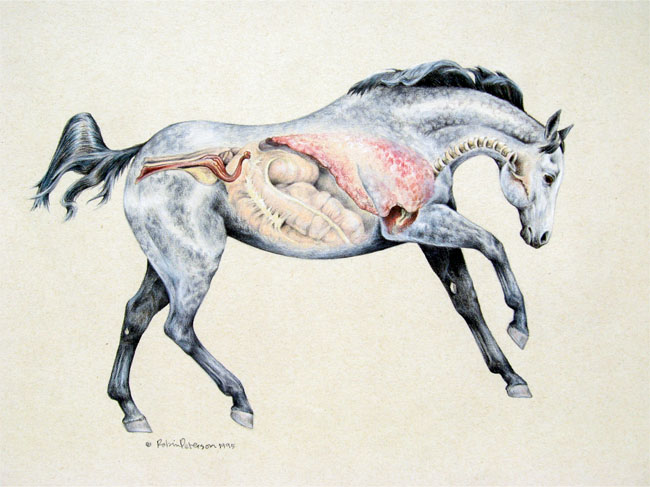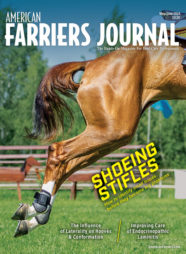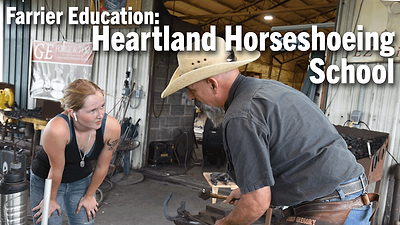For all of the stable-management and health-care expertise I’ve accumulated over more than 30 years, the trimming of feet is one area that I never dared delve into.
So I admit it — I’m in awe of farriers.
With so much knowledge of anatomy, so much experience and intuition needed to safely and effectively shape a foot, I was never confident enough that I wouldn’t make a train wreck of trying. So I have always entrusted the care of my horses’ hooves to an expert farrier, and treated him (or her) with the deference appropriate to that expertise.
I’m not the only horse owner who feels this way — and I also know that farriers are the horse-care professionals who the typical horse person sees most regularly. So it’s inevitable, really, that farriers are asked questions that go way beyond the scope of hoof care. You’re expected to have an opinion on everything from the talents of the local trainer to why a Clydesdale might be losing its feathers.
In particular, you’re often supposed to be equipped to inform your clients about nutrition — both in terms of how it affects hoof growth and the overall health of their horses.
What’s better, sweet feed or pellets? What do you think about rice bran, flax seed or shark cartilage? What level of protein should I be feeding my mare when she’s 5 months pregnant? Did you see that new study about chromium levels in the diet? How should I be feeding my horse with hyperkalemic periodic paralysis (HYPP), equine polysaccharide storage myopathy (EPSM), insulin resistance or Cushing’s disease?
It’s enough to make a shoer’s head spin — and I’m willing to bet that little of this was covered in your schooling or apprenticeship. But while I’m hopeless with a rasp, nutrition is a subject that I do know, and this new series is designed to make you better equipped to field the tricky nutrition questions that clients keep firing in your direction.
Let’s start at the beginning, with a short tour of the equine innards and how its design affects what horses can — and should — digest.
The Magical Tummy Tour
Unlike humans with our omnivorous tastes, horses are strict herbivores. Forage is the basis of the equine diet, and when forage is of good quality and in plentiful supply, horses suffer few digestive difficulties.
At first glance, the equine digestive tract seems strangely out of proportion. Take the equine stomach, for example. It’s surprisingly small for an animal the size of the horse — with a capacity of only 2 to 4 gallons. In contrast, the small intestine can reach an amazing 70 feet in length, with a diameter of 3 to 4 inches and a capacity of 10 to 12 gallons.
While this disparity might seem a little curious, it’s the perfect evolutionary solution for a nomadic, herbivorous beast. In his or her wild state, a horse would never ingest large quantities of food at one sitting, so his digestive system is optimally designed for a wandering, grazing lifestyle.
When a horse tears off a mouthful of grass with his teeth, or uses his almost-prehensile lips to pick up hay or grain, the food is transferred to the back of his mouth via the tongue. It is then ground by the horse’s wide, flat molars and mixed with saliva, which immediately begins to break down starches, even before a mouthful of grain or forage is swallowed.
Once thoroughly chewed, a mouthful of oats will have absorbed its own weight in moisture, while a mouthful of hay will have absorbed about four times its own weight.
From there, the base of the tongue pushes the food past the soft palate and into the pharynx, the opening to the esophagus. The esophagus, a flexible tube that leads down the neck to the stomach, pushes food along with a series of muscular contractions, which move in only one direction. For better or worse, what goes down stays down, as horses have no capacity for reverse peristalsis (vomiting).
Where Digestion Occurs
Surprisingly little digestion goes on in the equine stomach. There is a small microbial population, which initiates some fermentation and some enzymatic action. But because food typically remains in the stomach for only 15 minutes before being pushed on to the small intestine, there’s little time for any major food breakdown.
The main job of the stomach is to liquefy the food with a volatile mixture of acids. As soon as the stomach reaches about two-thirds of its capacity, it typically starts to pass the liquefied food on to the small intestine, a process that continues as long as the horse keeps eating.

FROM START TO FINISH. This illustration demonstrates how feed is routed through the entire equine digestive system.
Although food remains in the stomach for a very brief interval, its presence (or absence) has a direct bearing on the horse’s health. The upper, inner portion of the stomach’s lining is made up of a non-glandular, squamous cell layer, which is vulnerable to the hydrochloric acid that the stomach secretes. Keeping food in the stomach at frequent intervals tends to absorb the acid and keep it from splashing this upper layer.
Horses that are fed infrequently (only one or two large meals a day, rather than several smaller meals) are more at risk for suffering from gastric ulcers, which can result from exposure to stomach acids. Horses fed a hay-only diet typically have a very low incidence of ulcers, because forage absorbs the acids quite well, while horses on high-grain diets are more at risk.
Small Intestine Digests Protein
The next stop on the tummy tour is the small intestine, a coiled and convoluted tube suspended from the loin region by a fan-shaped membrane called the mesentery. The small intestine represents 30 percent of the gastrointestinal (GI) tract’s total capacity and it is the primary site for protein digestion and absorption of amino acids. On the whole, the small intestine does a more thorough job of processing grains than forages.
Inside the small intestine, enzymes go to work to break down the food materials. Starch that has not already been digested by saliva is converted to a simple sugar called maltose. Other complex sugars and carbohydrates are broken down into simple-sugar forms so that they can be absorbed through the intestinal walls.
They are transported by capillaries into the blood and eventually arrive at the liver, the horse’s major chemical processing plant. The liver also sorts amino acids and reorganizes them back into proteins, and binds water-soluble nutrients to their appropriate carriers for distribution throughout the body.
The small intestine is also the primary site for digestion and absorption of fats. Most animals use gall bladder secretions to break down fats, but horses have no gall bladder, another evolutionary peculiarity. Nonetheless, horses seem able to use diets containing a certain amount of fat, and they efficiently digest this ingredient. The fat-soluble vitamins A, D, E and K are also absorbed in the small intestine, as are calcium, some phosphorus and B vitamins.
The first section of the small intestine, the duodenum, does a U-turn, which helps prevent food from being forced back into the stomach if the small intestine becomes distended. It normally takes 60 to 90 minutes for food to pass through the entire length of the small intestine to the hindgut.
The last portion of the small intestine, the ileum, leads to the final section of the gastrointestinal tour: the hindgut, or large intestine, composed of the cecum, large (or ascending) colon, small colon, rectum and anus.
Hindgut Digestion
Here’s where the bulk of the hard digestion work is done. Instead of enzymes doing the honors, digestion in the hindgut is largely microbial — performed by billions of symbiotic bacteria, which efficiently break down plant fibers into simpler compounds called volatile fatty acids (VFAs), which can be absorbed through the gut wall. Not only are these bacteria a natural part of the digestive process, they’re essential — as we’ll see in a future article when we discuss fiber digestion in more detail.
The cecum, approximately 4 feet long and with a capacity of 7 to 9 gallons, is a huge factory for hindgut digestion. It begins high in the horse’s right flank area and extends down and forward toward the diaphragm. Plant fibers, composed of cellulose and other tough-to-digest molecules, pass through the stomach and small intestine essentially untouched by the digestive enzymes. But when they hit the fermentation vat of the cecum, the population of bacteria found there makes short work of them, breaking them down in about 5 hours.
The size and structure of the cecum (the physiological equivalent to a human’s appendix, but far more useful) slows the passage of food in order for the microbes to more effectively do their job.
Colon Consequences
From the cecum, partially digested food moves on to the large colon, where fermentation continues. Averaging 12 feet in length and holding an impressive 14 to 16 gallons of food (about 38 percent of the GI tract’s total capacity), the large colon is where food dwells the longest — 36 to 48 hours.
Its construction resembles a series of pouches that can facilitate the breakdown of large quantities of fibrous material. However, it can also become a risk factor when the pouches become distended with gas during a bout of colic. They seem custom-made for twisting and even strangulating their own tissues.
Assuming no colic occurs, food processed in the large colon moves to the small colon — another 10 to 12 feet long, but smaller in diameter (about 4 inches). The vast majority of nutrients have been absorbed by this time, and what’s left in the gut is whatever the horse cannot digest or use.
The main function of this portion of the hindgut is to reclaim excess moisture from the remaining material. By the time it leaves the small colon, the food has become solid again and has been molded into fecal balls. The small colon empties into the rectum. Some 36 to 72 hours after it began its journey, the waste material from a horse’s meal is expelled as manure.
Checks And Balances
The equine GI tract functions very well under normal conditions. But as every horseman knows, it’s extremely sensitive and easy to upset. Any sudden change in diet can severely compromise the population of gut bacteria, which is essential for fiber digestion. When these bacteria start dying off, the horse is at risk for colic, or at the very least is not getting all the nutrients out of his or her feed. Hence it’s always best if feed changes are made gradually, over a period of a couple of weeks, rather than suddenly.
Another trigger for digestive upset occurs when the horse receives a large, carbohydrate-rich meal (typically, one that is light on forage and heavy on grain). Under these conditions, the small intestine might not be able to completely process and absorb all of the nutrients before the meal moves on to the hindgut. When excess amounts of soluble carbohydrates reach the fermentation vat of the cecum, they produce not only VFAs, but also lactic acid.
An increase in lactic acid lowers the overall hindgut pH level, which can lead to an environment that is hostile for the gut bacteria. They begin to die off, and in the process can release endotoxins (poisons), setting the stage for colic or laminitis. Suddenly the old horseman’s rule of frequently feeding small amounts of a ration begins to make a lot of sense.
Forage Benefits
The closer you stick to the horse’s natural diet, the healthier his or her digestive system will be, and that means one thing: forage. Lots of it.
In the wild, horses graze for 14 hours or more every day, and their broad, flat teeth and sideways chewing motions are ideally suited to process the tough, stemmy grasses and weeds that they favor. Like all true herbivores, horses are designed to derive their daily energy requirements from eating these plant fibers.
While we often provide grain and supplemental fats to provide horses with added energy in order to do hard work — work they’d never choose to do on their own — it’s important to remember that it’s forage that horses were meant to use as fuel. It provides all the energy that horses need for everyday maintenance metabolism to handle ordinary functions like breathing, walking, grazing and sleeping.
Forage not only provides maintenance energy, but it also helps to assure the horse’s good digestive health. The portion of the indigestible fiber contained in pasture plants serves to stimulate the cells of the gut to keep food moving along the passageway instead of becoming impacted.
Without adequate forage, the GI tract loses the ability to move food particles efficiently through the gut, and its ability to conserve water and electrolytes is compromised. The result is a horse at risk for dehydration, colic and laminitis — not to mention stable vices like cribbing and wood chewing — which often develop when the fundamental urge to chew is not satisfied.
In an ideal world, horses would source their fiber from grazed forages year-round. But very few owners have the luxury of good pasture 12 months out of the year, so they frequently turn to alternate fiber sources, such as hay, haylage, processed hay products such as roughage cubes or pellets, or sugar beet pulp. All of these can do an excellent job of satisfying a horse’s need for roughage.
As a rule of thumb, fiber should always make up at least 50 percent (by weight) of a horse’s daily diet. For the vast majority of adult horses, that percentage can be pushed up considerably higher — even to 100 percent, if the horse is an easy keeper and/or not asked to do work.
The basic principle is this: grain is an optional part of a horse’s diet; fiber is not. I’ll address types and sources of fiber in more detail in the next issue.
Why Nutrition Knowledge Is SO Critical To Hoof-Care Professionals
- 84 percent of farriers recommend products and brands to horse owners and trainers.
- 62 percent of farriers are asked by shoeing clients for specific recommendations on hoof supplements.
- 32 percent are asked for advice on selecting and utilizing various types of rations, supplements and feed products.
- 47 percent are asked for guidelines on joint supplements.
- Among the dozen most common product categories that are recommended by farriers to horse owners and trainers, half are nutrition-related products. These include feeds, nutritional supplements, hoof supplements, joint supplements, mineral supplements and vitamin supplements.







Post a comment
Report Abusive Comment